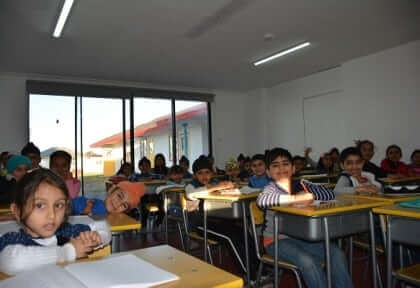A visit to Glenwood’s Punjabi school
Albel Singh Kang, one of the senior administrators of Guru Nanak Public School in Glenwood, Sydney, beamed with pride as he said, “This is one of the happiest moments of ours as a feeder school. The first batch that trained in this school and continued learning Punjabi is sitting for the HSC exams this year.”

The school, which offers classes in the language to around 600 students, is one among five Punjabi language schools in Sydney, the others being Revesby, Epping, Penrith and Minto schools.
When the Indian Link team visited the school in Glenwood recently, teachers were filing in and signing the attendance registers in a systematic manner, just like at a regular school. What followed was the school assembly where children lined up, sang the Australian national anthem and an inspirational bhajan, and some instructions were passed on.

As they dispersed to attend their respective classes, Jasvinder Bal, one of the 30 teachers, sat down to have a chat with us.
“We follow a syllabus that reflects on what is taught in India, however we incorporate the input of teachers, management and the parents before we finalise it all,” she outlined. “Everything is based on what we want the students to achieve; lesson plans are developed aligning with the syllabus, and different strategies are used to achieve the target of students learning the language and culture.”
The school runs for two hours every Saturday, in two shifts.
The children themselves revealed a wide variety of reasons as to why they attend the school.

“I want to learn a second language; it will make me smart,” one said.
Another revealed, “It helps me communicate better with my family back in India.”
Yet another said simply, “My grandma thinks I should learn Punjabi.”
Whatever the reasons, one thing was for certain – they were all motivated.
Observed Gurinder Kang, one of the administrators of the school, “We can certainly inspire them, but what keeps the children motivated is the support they receive from the parents. And we are really lucky to have highly committed parents here.”
Charanjeet, one of the parents, agreed. “Of course, being a child, my boy is reluctant to attend the school at times, but I believe it is my responsibility to give my child an opportunity to learn our language and culture. He needs to maintain his identity as a Punjabi, regardless of which country he grows up in.”

The child’s family is also rewarded for bringing their child to the school. There are facilities for parents or grandparents to attend community English or computer classes in the school’s fully-fledged computer lab.
What does the school do to give the students cultural exposure?
“Our goal is to not just teach the kids the alphabet, they should express themselves in the language, which in turn will keep them attached to their roots,” Mr Kang noted. “Speaking, listening, writing and reading are the four outcomes in our syllabus. We try to celebrate the festivals, promote community initiatives like the Census, where they can vocalise their identity as Punjabis in Australia. The kids who make the best effort are recognised in our annual day function. There is a regular newsletter that is sent out every month that contains details about the community activities as well as the school’s specific ones.”

As for challenges, he identified time constraints of the volunteers as the biggest hurdle in the running of the school. In the rush to manage a work-life balance, it is hard to find time for its activities. In saying that, they try to gather the best of available talent, by choosing people with language teaching qualifications from India. It is also mandatory that the teachers do a Working With Children check
The school offers facilities for adults to learn the language too. Last year, they saw a few people coming to learn Punjabi that included Fiji Indians and people of Caucasian origin.
Strong feelings of cultural identity and patriotism seem to be the underpinning factors that drive many of these people. The firm belief that, “Punjabi is our mother tongue and we shouldn’t let it terminate with our generation,” as Charanjeet said, propels this group of people to do all they can to keep it going. It is not just a language that is taught over here; it is the legacy and traditions of Punjab as well.




